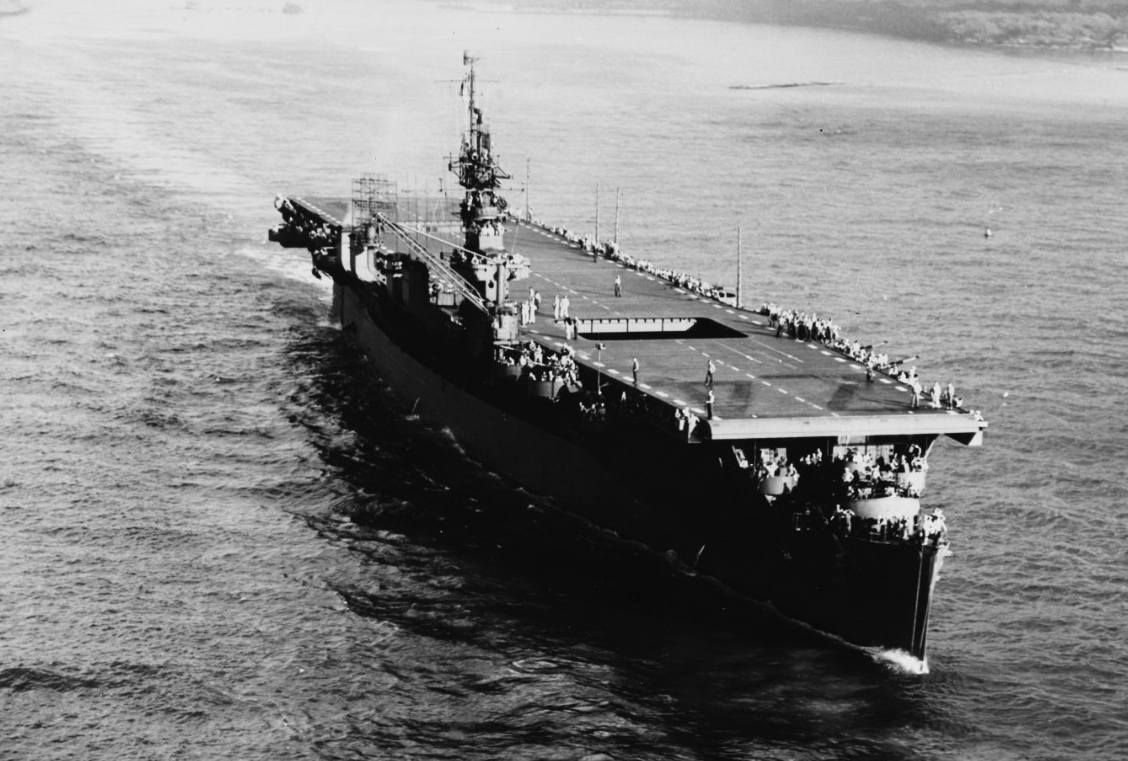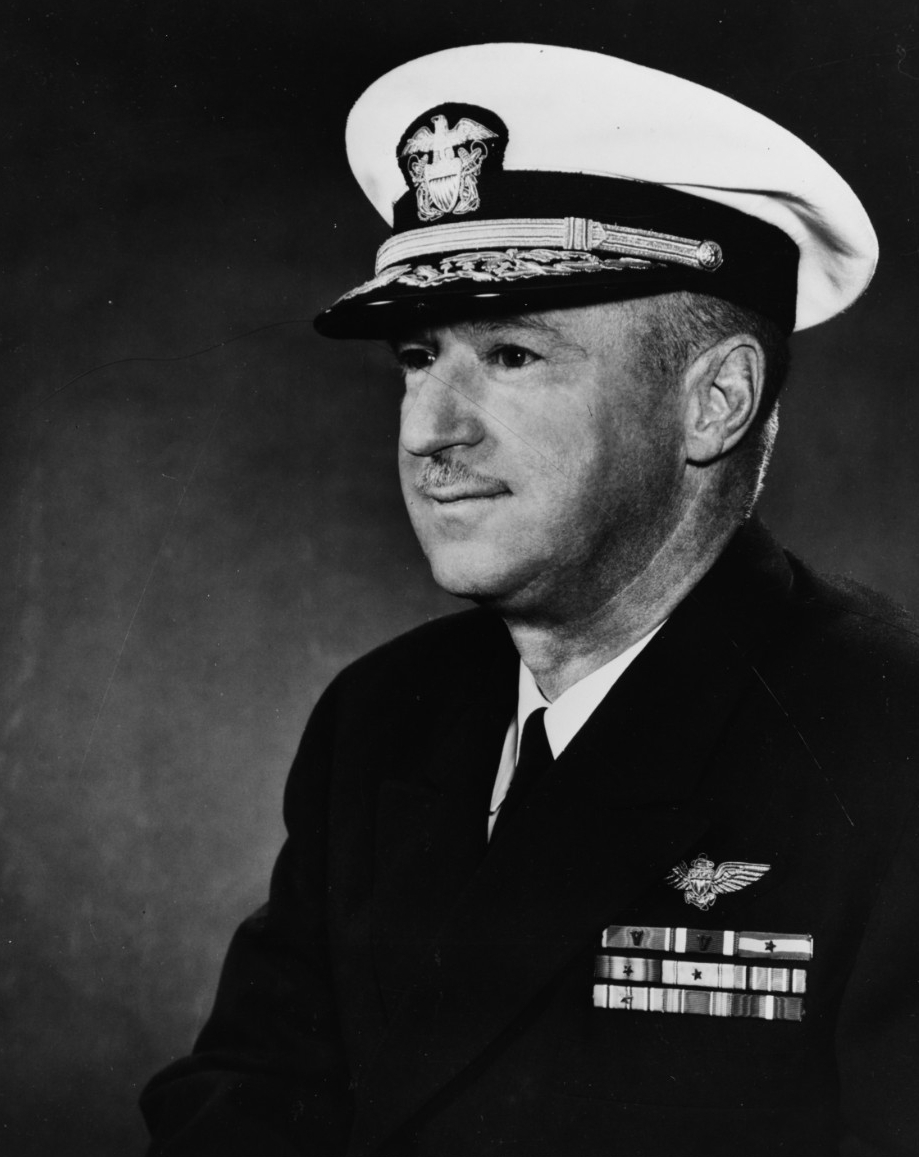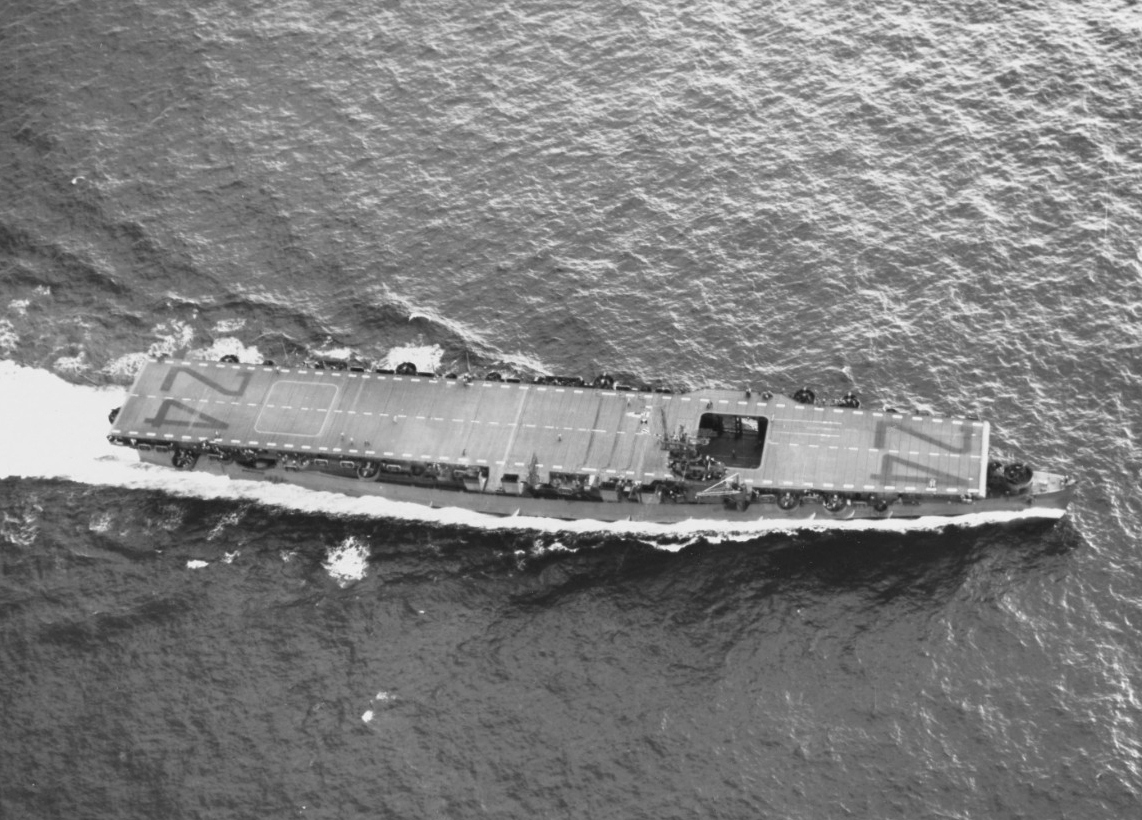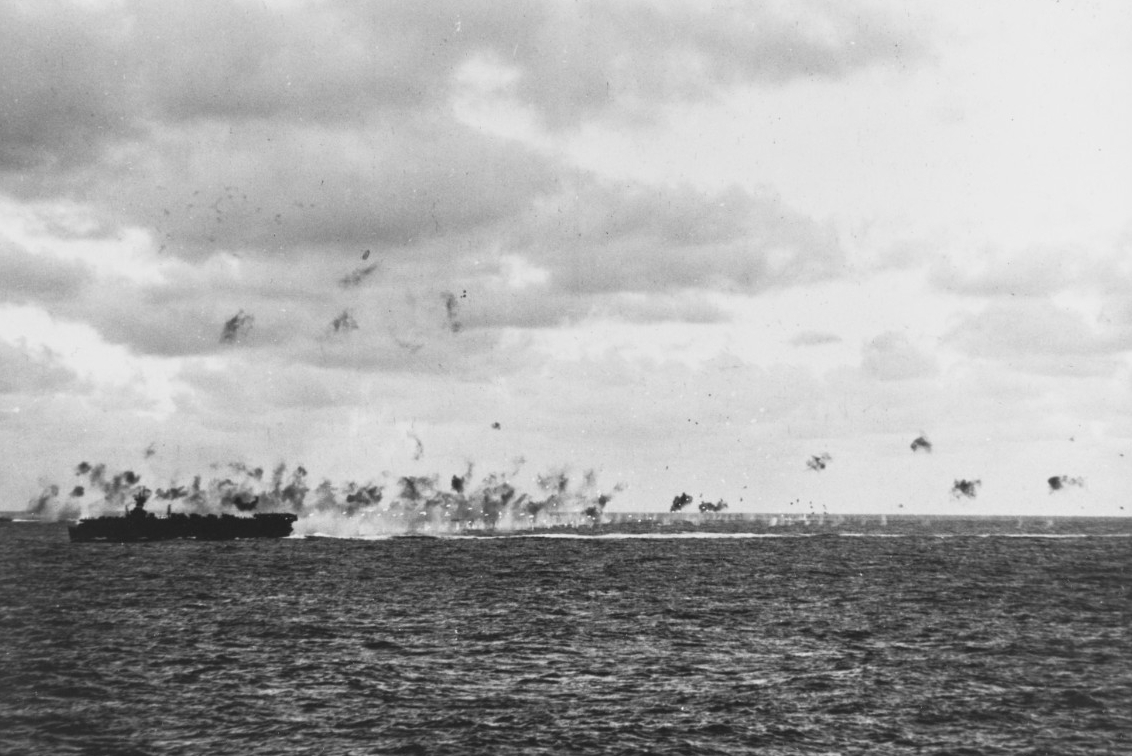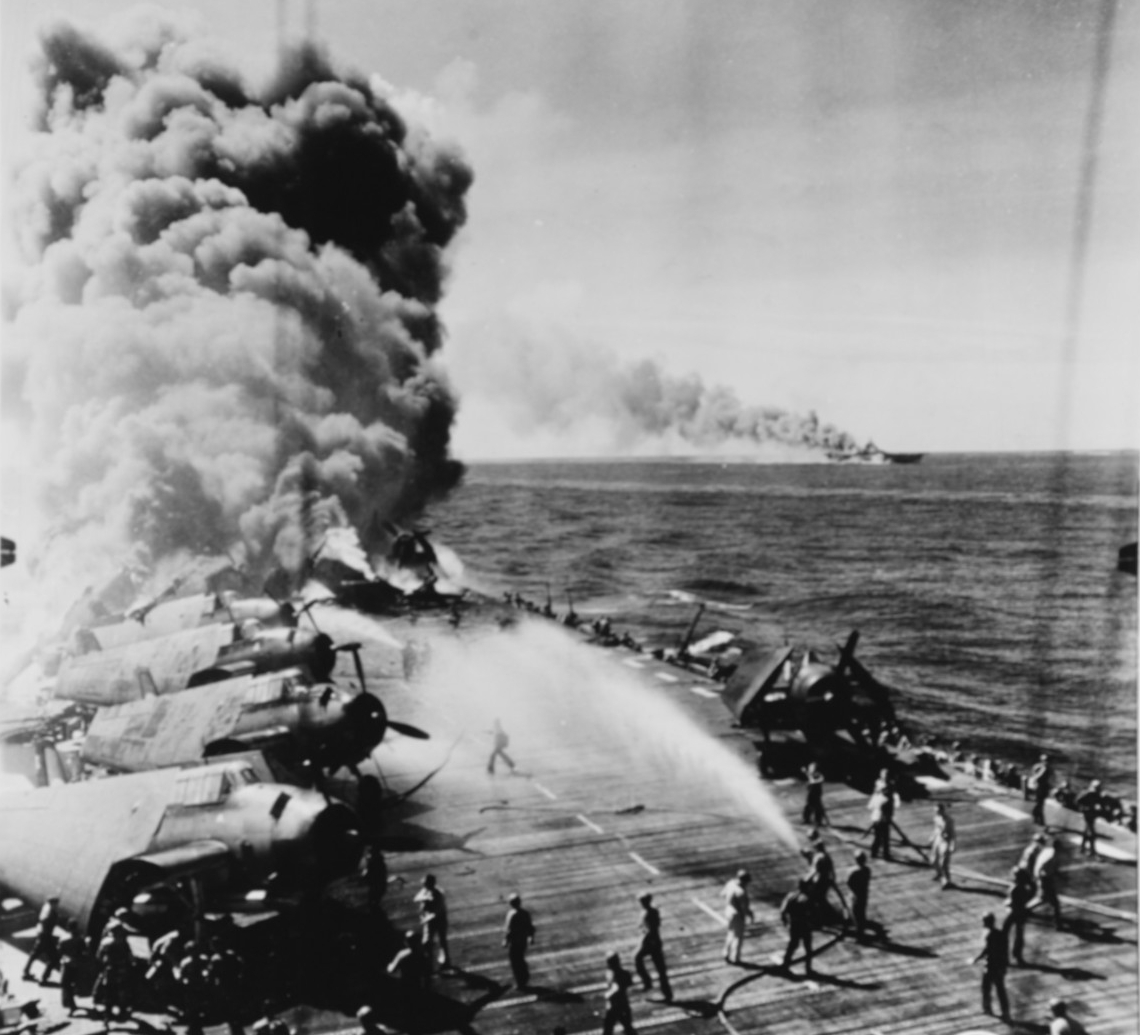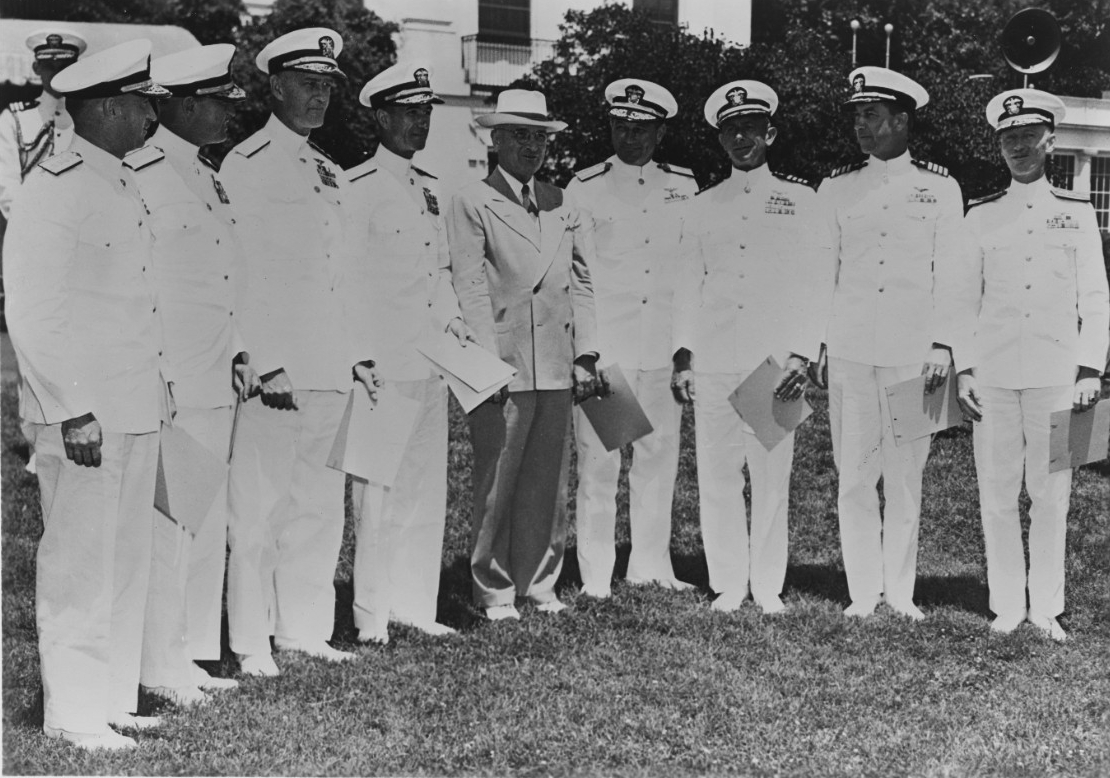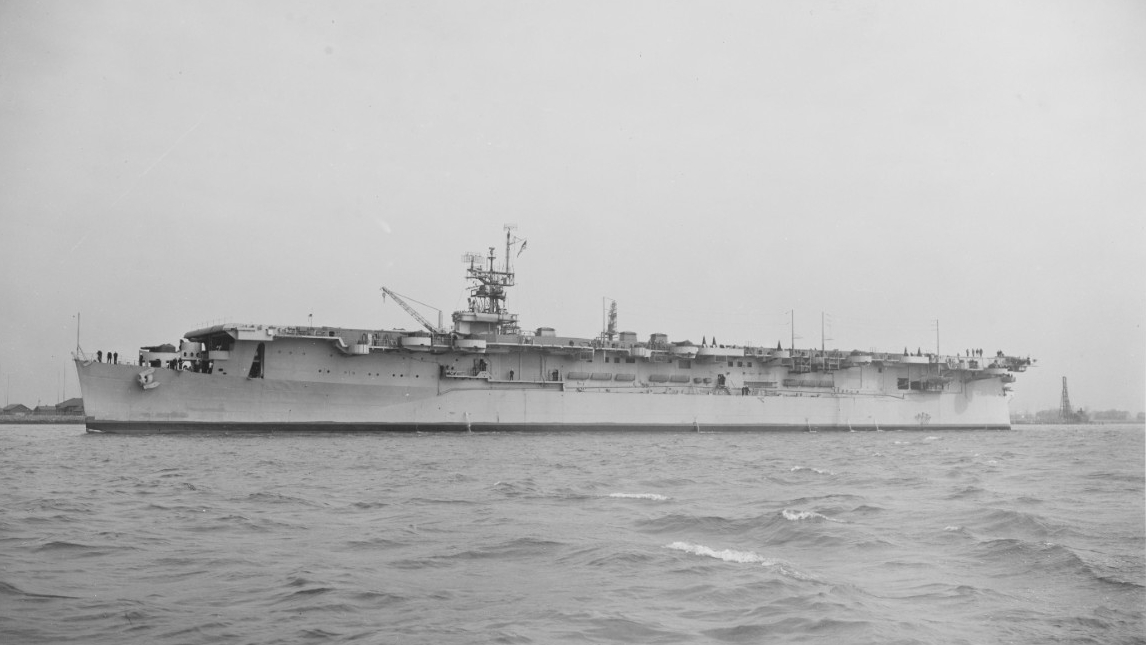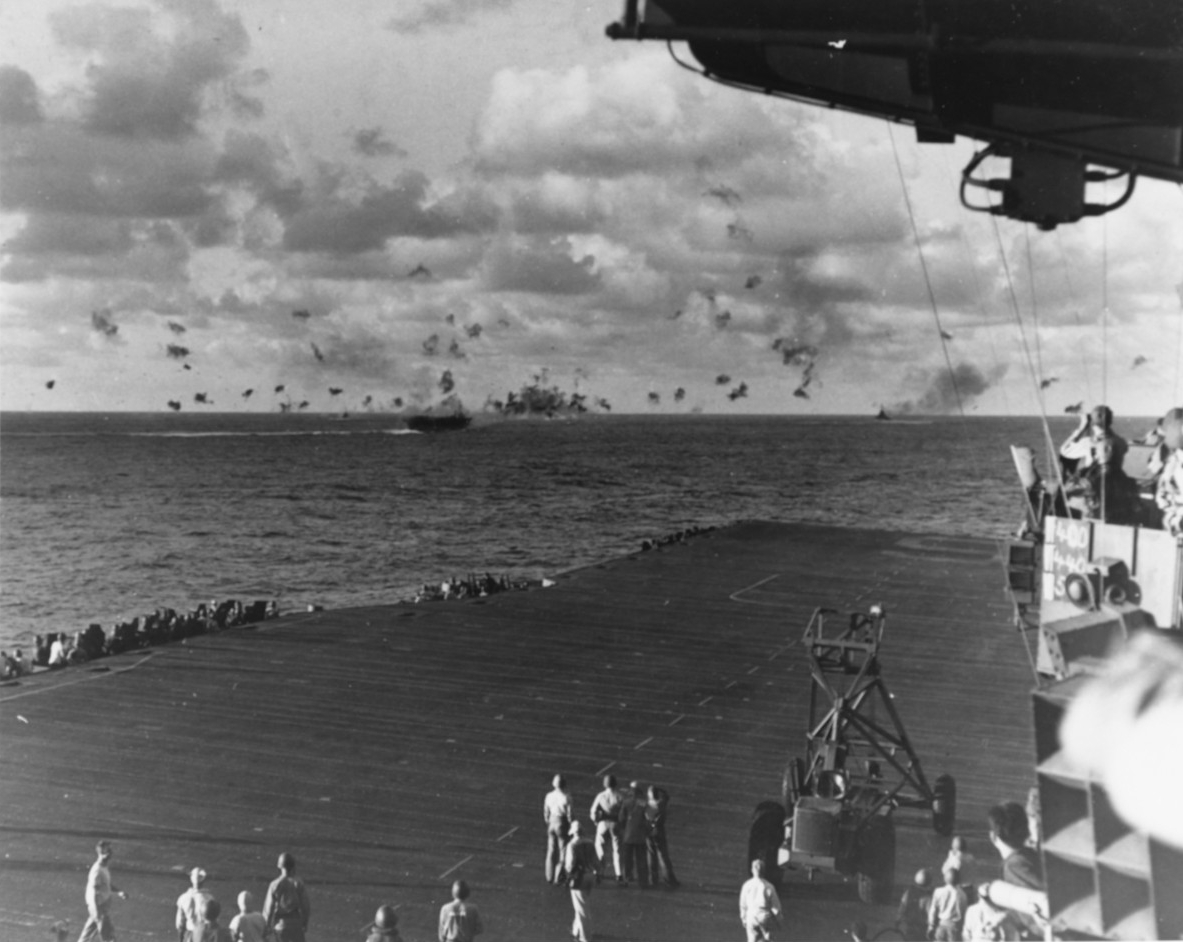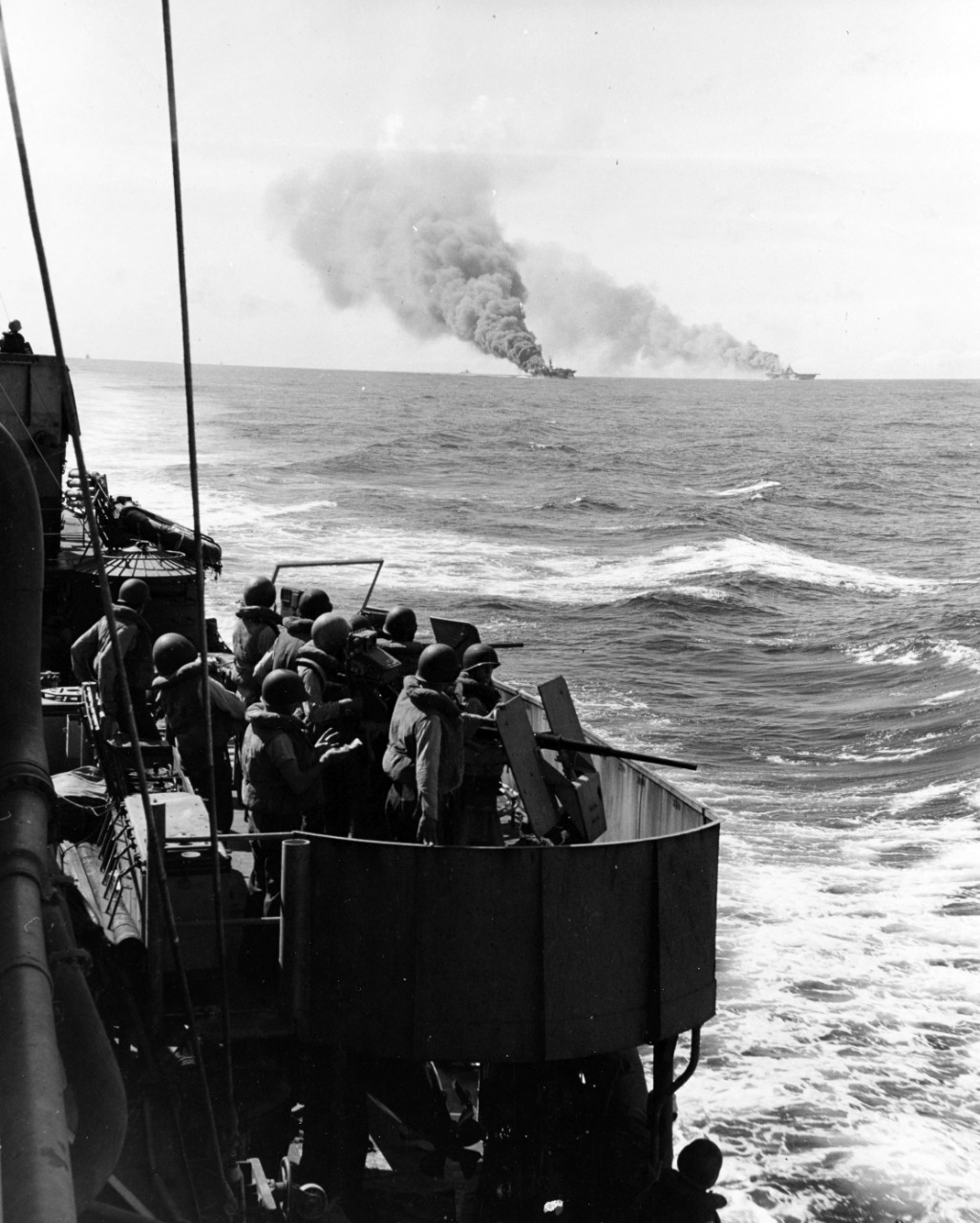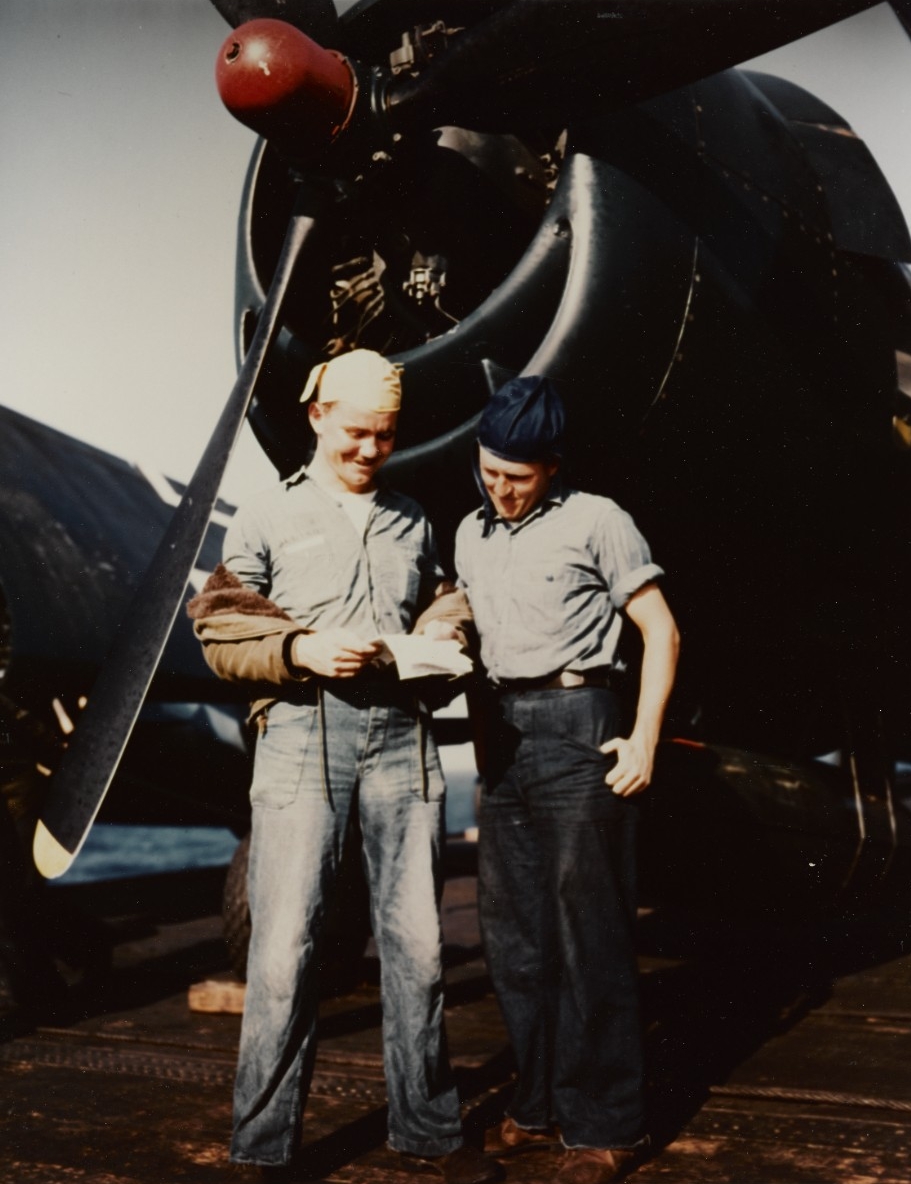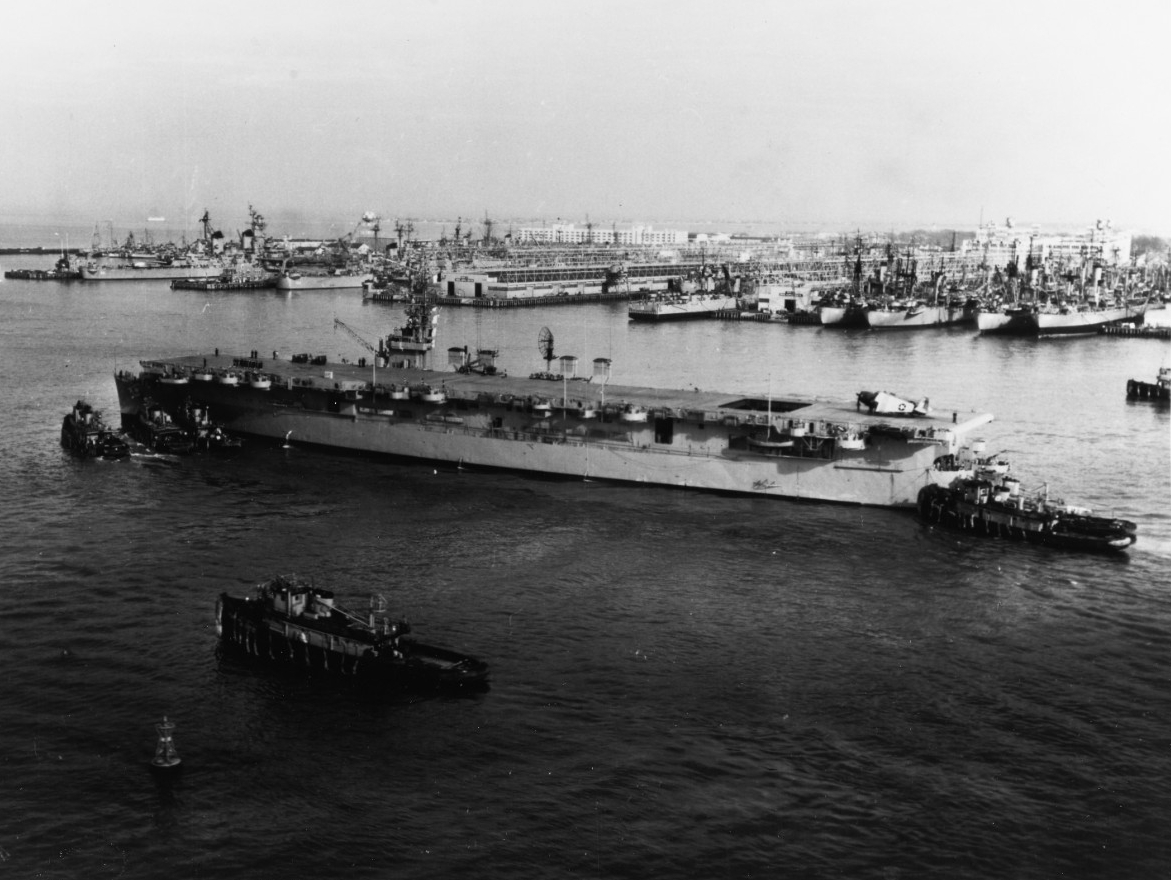USS Belleau Wood (CVL-24)
Originally projected as a light cruiser, USS Belleau Wood was redesignated an aircraft carrier (CV-24) and named in March 1942 to honor the World War I battlefield near Chateau Thierry, France, where soldiers of the 2nd Infantry Division, along with the attached 4th Marine Brigade, defeated German troops after four weeks of intense battle. Belleau Wood was commissioned on 31 March 1943 with Captain Alfred M. Pride in command. After preliminary training in the Chesapeake Bay, Belleau Wood steamed for the West Indies, where she conducted her shakedown cruise. Returning to the United States on 3 July, the ship underwent a series of post-shakedown repairs, inspections, and alterations at the Philadelphia Navy Yard. During the modifications, Belleau Wood was redesignated a small aircraft carrier (CVL-24) on 15 July. About a week later, Belleau Wood was underway—via the Panama Canal—for the Pacific, arriving at Balboa, California, 26 July. Two days later, in company with USS Lexington (CV-16), USS Princeton (CVL-23), and six escorts, Belleau Wood steamed for Pearl Harbor, arriving on 9 August. For the next few weeks, her crew prepared for the reoccupation of Baker Island in the south Pacific.
Assigned to Task Group (TG) 11.2, Belleau Wood departed “Pearl” on 25 August, crossed the equator, and arrived off Baker Island on 1 September some 400 miles east of the Japanese occupied Gilbert Islands. During her first day of operations, the carrier scored its first kill of the war when one of her F6F Hellcat fighters splashed a Kawanishi H8K four-engine “Emily” flying boat. For the next two weeks, Belleau Wood’s aviation assets patrolled the skies above Baker Island, protecting Army troops on the ground and Navy construction battalions (Seabees) as they built an airstrip. On 18–19 September, the task group rendezvoused with Lexington and conducted air strikes against Japanese gunboats and air defense positions in the Gilbert Islands. Belleau Wood briefly returned to Pearl Harbor to refuel and rearm before she set out for an air raid on Wake Island. On 5 October, in company with TG 14.5, Belleau Wood began to conduct combat air patrols over the task force. During the first day of the operation, Belleau Wood’s fighters downed three enemy “Zeke” carrier fighters and three “Bettys.” Later, she launched two strikes of 10 Avengers and 14 Hellcats on Wake, but lost two fighters during the sweep. Antiaircraft fire accounted for one of the losses, and the second one crash-landed on Belleau Wood, killing four of the carrier’s flight deck crew. Belleau Wood returned to Pearl Harbor on 11 October, where she underwent four weeks of replenishment and additional training.
On 10 November, Belleau Wood departed Pearl Harbor to participate in Operation Galvanic—the seizure of Makin and Tarawa. Joining the Northern Carrier Group as part of TG 50.2, she provided support to USS Enterprise (CV-6) and USS Monterey (CVL-26) in strikes on Makin, 19 November. Fighter sweeps continued over the atolls until 26 November when they were declared secure. The next day, Belleau Wood joined TG 50.3, centered on USS Essex (CV-9) and Enterprise, for strikes on the Marshall Islands. On 4 December, Belleau Wood covered the task group as the larger carriers launched a series of raids on Kwajalein and Wotje. During that evening, several Japanese bombers approached Belleau Wood and a “Betty” managed to drop a torpedo that was nearly on target. An emergency hard left helped her avoid the torpedo, which missed 10 yards to starboard. Lexington was less fortunate as an aerial torpedo struck her that subsequently sent the task group back to Pearl Harbor for repairs and replenishment.
On 16 January 1944, Belleau Wood departed Pearl Harbor to participate in Operation Flintlock—the seizure of Majuro, Kwajalein, and Eniwetok in the Marshall Islands. On 29 January, TG 58. 1, along with nine more carriers in three other task groups, began launching attacks on Japanese airfields. Although Belleau Wood 's aircraft mainly flew combat air patrols, she did launch one fighter sweep over Taroa airfield, losing two aircraft to ground fire. For the next five days, the light carrier’s planes flew raids in support of Marine Corps and Army forces, losing another three planes to antiaircraft fire. After refueling and reprovisioning at Majuro on 4 February, the task group returned to Kwajalein for a week of patrols over the ships supporting the conquest of the atoll.
Ordered west for a raid on Tinian and Saipan, Belleau Wood flew her usual combat air patrols as the large carriers struck shore targets. On 22 February, two “Bettys” surprised the task group and closed in on Belleau Wood. The first enemy aircraft passed over the flight deck, however, her starboard automatic weapons splashed the enemy aircraft about 200 feet away. The second Japanese aircraft was also splashed by Belleau Wood’s 20-millimeter and 40-millimeter guns about 500 yards in front of the ship. In addition, her 20-millimeter batteries claimed a Kawasaki Ki. 61 “Tony” fighter, which had just attacked Essex. Meanwhile, Belleau Wood’s aircraft downed two Kawasaki Ki. 48 “Lily” light bombers. Belleau Wood then steamed for Majuro, where she spent the next two weeks replenishing the ship and loading new aircraft.
In company with Enterprise in TG 58.1, Belleau Wood was underway on 7 March for Espiritu Santo, arriving there five days later. Three days later, the task group helped cover the uncontested landings on Emirau before beginning a series of air strikes in the Western Carolines and on New Guinea, which were intended to support planned American amphibious operations in the Humboldt Bay-Tanahmerah region of New Guinea. On 30 March, fighter sweeps struck airfields and shipping on Palau. Belleau Wood’s bombers struck Yap, while her fighters strafed Ngulu and Ulithi. Her combat air patrols continued their series of success by splashing two “Bettys” on 31 March. The next day, Belleau Wood’s aircraft destroyed an additional seven enemy planes on the ground. Belleau Wood continued her support of the larger carrier strikes in the area of operations throughout the months of April and May.
On 11 June, as part of the task group attacking Guam, Belleau Wood launched a fighter sweep against Japanese airfields, which shot down four “Zekes” without loss. The next day, she launched fighter sweeps over Guam and Rota that claimed another “Zeke” and a Kawasaki Ki. 45 “Nick” fighter. Ordered to strike HaHa and ChiChi Jima on 15 June, Belleau Wood’s aircraft bombed and sank a large cargo ship in Futami Bay. That evening, a returning Hellcat crashed through a barrier, struck the carriers island, and burst into flames. It took damage-control crews just 23 minutes to put out the fires and no one was injured. On 16 June, after a morning of fighter sweeps over Iwo Jima, the task group received reports of a large Japanese force moving in on the Marianas from the Philippines. Rather than carry out the planned strikes that afternoon on Iwo Jima, the task group hurried south to join three carrier groups. Around noon on 18 June, the carriers took up a patrol station some 150 miles west of Saipan.
From that position, on the northern flank of the carrier forces, Belleau Wood participated in the Battle of the Philippine Sea. During the first day of the battle, Belleau Wood’s aircraft downed 10 “Zekes,” a portion of the more than 300 Japanese aircraft lost in the battle dubbed the Great Marianas Turkey Shoot. On 20 June, Belleau Wood launched combat air patrols as the task force prepared for the second day of battle. However, the Japanese force had begun to retire west the previous evening and American search planes could not locate them. Later that day, after hearing a sighting of the enemy force, Belleau Wood launched six fighters and four bombers that caught the Japanese force at dusk, sinking light carrier Hiyo and three “Zekes” in air combat. After a futile chase the following day, the task group returned to the Marianas. Belleau Wood conducted combat air patrols, refueled, recovered aircraft that were on other carriers, and helped search for pilots that were still in the water. The task group returned to the Bonin Islands, where they finished off the remaining Japanese planes. The task group then retired to the Marshalls on 27 June. Belleau Wood stayed there only briefly, having been ordered back to Pearl Harbor for improvements to her aircraft ordnance capability.
Belleau Wood returned to the front lines of the Pacific War on 2 August and continued to support strike operations with combat air patrols and fighter sweeps for the next couple of months. On 14 October, TF 38.4 began strikes against the Philippines in support of the upcoming Leyte landings. The Aparri airfields were hit first. Over the next six days, Belleau Wood’s aircraft helped work over the Manila Bay area and Leyte, claiming 11 enemy planes, two cargo ships, and a tanker. The light carrier then provided combat air patrols for the Leyte landing on 20 and 23 October. The Japanese responded to the invasion by sending four task groups to intercept the Americans. This began a series of actions that resulted in what is now known as the Battle of Leyte Gulf. On 24 October, Belleau Wood’s task group took station off Samar and launched aircraft to hunt down the Japanese. Having spotted one of the enemy groups, Task Force 38.4 launched a strike of 26 fighters and 39 bombers. In the ensuing attack, Belleau Wood’s planes scored a hit on an enemy battleship. That evening, her task group received orders to intercept and sink four Japanese carriers spotted north of the Philippines. Although Belleau Wood’s planes only played a supporting role in the Battle off Cape Engaño on 25 October, where four Japanese carriers were sunk, her Avengers did help sink light cruiser Tana. After refueling the following day, TF 38.4 spent the next four days providing air cover and strikes against enemy shipping. In response, Japanese pilots began flying suicide missions—kamikaze attacks—against American ships in the Philippines. On 29 October, USS Intrepid (CV-11) was damaged by a kamikaze attack. The following day, as the task group operated near Leyte, five kamikazes were spotted at 18,000-feet. Antiaircraft fire splashed three, but one crashed on USS Franklin (CV-13) killing 56 and wounding another 14. The fifth plane first dropped a bomb on Franklin, and then pulled up and dove on Belleau Wood. The Japanese fighter crashed into the light carrier’s flight deck, striking 11 fully loaded Hellcats. Several explosions started extensive fires that took three hours for damage-control teams to get under control. With her flight deck holed and casualties numbering 92 killed and another 97 wounded, Belleau Wood retired to the Carolines. Ultimately, Belleau Wood made way for San Francisco, where she remained until mid-January 1945 for extensive repairs.
On 7 February, Belleau Wood arrived at Ulithi, and three days later, joined TG 58.1 for strikes on the Japanese home islands. The strikes were designed to prevent enemy aircraft from interfering with the upcoming Iwo Jima and Okinawa operations planned for February and April, respectively. On 16 February, the task group steamed to a position roughly 125 miles from Tokyo. From there, the carriers launched repeated strikes against airfields in the region, destroying several hundred enemy aircraft. After bad weather cancelled the remaining strikes, the task force steamed south to support the planned 19 February amphibious landings on Iwo Jima. Over the next five days, Belleau Wood’s aircraft flew combat air patrols over Iwo Jima and bombed the Susaki airfield on Chichi Jima to deny its use to the enemy. Then, in an effort to stop the incessant kamikaze attacks, the group steamed north for another raid on Tokyo, but once again bad weather put the brakes on the raid. However, the task group turned southwest for strikes on Okinawa. Although the light carrier’s aircraft primarily flew combat air patrols over the next few days, her Avengers conducted numerous rocket attacks on Okinawa. Following the strikes, the carriers retired to Ulithi to prepare for the upcoming invasion.
After ten days of replenishment, Belleau Wood joined TG 58.1 on 14 March for the last amphibious operation of the war, Okinawa. Between 23–28 March, Belleau Wood’s planes struck Okinawa and conducted fighter sweeps over Nansei Shoto. After supporting an attack on the Kyushu airfields with Boeing B-29 four-engine “Superfortress” bombers on 29 March, Belleau Wood flew combat patrols in support of Marine Corps operations on Okinawa. On 6 April, a “Zeke” closed in an attempted suicide attack, but Belleau Wood's antiaircraft battery splashed the plane about 30 yards away on the starboard beam. One enlisted crewmember was lost overboard in the ensuing underwater explosion.
On 7 April, Belleau Wood's planes took part in the Battle of the East China Sea when American search aircraft spotted a Japanese task force built around battleship Yamato. Hundreds of American carrier planes attacked the Japanese force as it steamed south from Kyushu. Belleau Wood's pilots scored hits on several enemy destroyers, helping to sink most of the task force and driving off the rest. The light carrier then spent the next three weeks conducting sweeps over Okinawa and air strikes on nearby Japanese airfields. She retired briefly at Ulithi to replenish, but for Belleau Wood, the rest of the Okinawa campaign was highlighted by several more weeks of grueling air attacks on Okinawa and Kyushu.
Following weeks of repairs and training, Belleau Wood was underway on 1 July for the Japanese home islands. There, the light carrier struck airfields in the Tokyo Bay area and launched rockets at targets of opportunity on Hokkaido. On 24 July, Belleau Wood deployed her aircraft to strike a naval base at Kure. There, they discovered and helped sink battleship-carrier Hyuga and 15 small craft in the harbor. Belleau Wood spent the rest of the war hunting Japanese planes in the air and those hidden in camouflaged airfields. After the Japanese surrendered, Belleau Wood was tasked with “Magic Carpet” duty, during which she transported thousands of war-weary servicemen back to the U.S. West Coast.
For the next year, Belleau Wood remained moored at various locations in the San Francisco Bay area undergoing conversion and inactivation until placed out of commission, in reserve, at the Alameda Naval Air Station, California, on 13 January 1947. She remained in “mothballs” until transferred to France on 5 September 1953 under the Mutual Defense Assistance Program. After serving in the French navy as Bois Belleau, the carrier was returned to U.S. Navy custody in early September 1960. She was sold to the Boston Metals Company on 21 November 1960 for scrapping.
Belleau Wood received 12 battle stars and a Presidential Unit Citation from President Harry S. Truman for her World War II service.
*****
Suggested Reading
- Naval Aviation
- Surface Navy
- Evolution of Aircraft Carriers
- H-Gram 026-1: Operation Flintlock—The Invasion of Kwajalein, 31 January 1944
- H-Gram 032: Operation Forager and the Battle of the Philippine Sea
- H-Gram 040-2: Leyte, Ormoc Bay, and Mindoro
- H-Gram 042: The Battle for Iwo Jima, February–March 1945
- USS Belleau Wood (CVL-24) Action Report: 10 February – 2 March 1945
Interviews with USS Belleau Wood (CVL-24) Crewmembers
- Cyril D. Smith
- Eugene M. Larsen
- Ellis R. Barker
- John A. Harper
- Herbert H. Hassenfratz
- William R. English
- Herman B. Witt
- Doyle R. Weaver
Video Footage
- Japanese attack on USS Belleau Wood (CVL-24)
- USS Belleau Wood (CVL-24) and USS Franklin (CV-13) hit by Japanese suicide attacks
- Damage to U.S. Carriers by Japanese Air Attack during World War II
- Japanese Planes Diving on Ships: Speech of Admiral Chester Nimitz
- Gun Camera Okinawa
- Japanese Planes Shot Down by Task Force during Raid on Truk Island
Selected Imagery
USS Belleau Wood (CVL-24) was burning aft after she was hit by a kamikaze while operating off the Philippines, 30 October 1944. Flight deck crewmen were moving undamaged TBM torpedo planes away from the flames as others fought the fires. USS Franklin (CV-13), also hit during a kamikaze attack, was on fire in the distance. National Archives photograph, 80-G-342020.
Holding their Presidential Unit Citations, officers of Task Forces 58 and 38 surround President Harry S. Truman on the south lawn of the White House, 16 July 1946. Citations were awarded as follows (left to right): Rear Admiral Alfred M. Pride of USS Belleau Wood (CVL-24); Rear Admiral Joseph J. Clark of USS Yorktown (CV-10); Rear Admiral Felix B. Stump of USS Lexington (CV-16); Rear Admiral John J. Ballentine of USS Bunker Hill (CV-17); Rear Admiral Austin K. Doyle of USS Hornet (CV-12); Captain Carlos W. Wieber of USS Essex (CV-9); Captain Clifford S. Cooper, executive officer of USS San Jacinto (CVL-30); and Rear Admiral Malcolm F. Schoeffel of USS Cabot (CVL-28). National Archives photograph, 80-G-702889.

